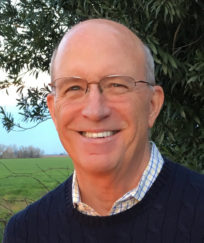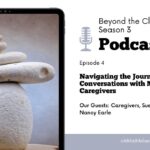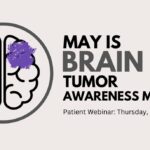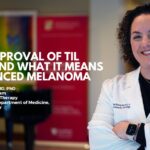Featured Survivor Story:


By Vallerie A. Malkin
Edgar Allan Poe said: “Never to suffer would never to have been blessed.”
These wise words by Poe could just as well have been uttered by Bob Polkinghorn, a 71-year-old melanoma survivor who credits the disease with making his personal foundation stronger.
“I didn’t know how much of a blessing it was,” says Bob, who was diagnosed in April 2016.
An easy retirement – or so he thought
A Southern California native who currently lives in Winters, near Sacramento, Bob exudes the kind of optimism and good humor that are contagious. He admits life has been good to him.

Bob Polkinghorn, Stage III Melanoma Survivor
In 2008 he retired from a satisfying career at the University of California (Berkeley) and the UC Office of the President, where he spent a total of 20 years in administrative roles, including teaching a master’s program in education policy with a focus on urban school leadership.
Prior to that, Bob enjoyed five years as an elementary school principal in Southern California. He also has fond memories of his 10 years as a middle school teacher in the public school system. Both of Bob’s sons followed his footsteps and became school principals.
After Bob retired, he and Kathy were hoping to spend some quality time with their family. They each had children from previous marriages—Bob three, Kathy two—and they have 15 grandchildren between them.
Bob and Kathy also hoped to do more traveling. But Bob got waylaid when his doctor saw something he didn’t like during a routine exam.
You have melanoma, but there is a lot of hope
Despite Bob’s upbeat attitude, he has always hated going to the doctor. What if they find something wrong? Bob’s fears got real in 2016 when his doctor wanted to remove and biopsy a mole on his back left shoulder. And Bob’s fears got very real when the pathology report came back with a diagnosis of melanoma and a suggestion that it had metastasized.
Bob wanted the cancer out immediately. He asked for a wide local excision on that same day and was given one.
Then his doctor ordered a PET scan. Sure enough, the PET lit up a possible cancer in one of his lymph nodes, and a fine needle aspiration in that node confirmed the melanoma.
“It’s a pretty frightening deal,” says Bob of learning the cancer had spread.
Keep the faith and find a doctor you have faith in
Bob was buoyed by the support of a devoted wife and family, loyal friends, and his own faith. He also had the good fortune to be referred to an oncologist who was highly regarded and with whom he connected instantly. “The referral was a blessing,” Bob says.
Dr. Adil Daud of the Helen Diller Family Comprehensive Cancer Center at the University of California, San Francisco (UCSF) impressed Bob from the get-go.
“My doctor was caring, brilliant, and such a warm-hearted person,” says Bob.
“He told me there is a sea change unfolding in terms of melanoma treatment since my father’s and grandfather’s time.”
Dr. Daud said it is a “very hopeful time” for melanoma treatments, and that news cushioned the blow that Bob had cancer. Bob recalls his racing heart beginning to beat more slowly as he listened to Dr. Daud.
Twenty-two lymph nodes were removed from under Bob’s left arm, and thankfully only one of them contained cancer. Bob’s melanoma was staged at IIIA. He walked away with a clean scan, and that positioned him well for treatment.
(Clinical) trials, tribulations, and blessings
“What surprised me is the doctor presented me with choices,” recalls Bob. “Sometimes I just wish the doctor would tell me what to do! But I saw that it was my choice.”
On the upside, being involved in choosing your treatment options is empowering. Bob’s doctor went over all of them. First, they could take an observational approach, with Bob getting a CT scan every three to six months.
Second, Bob could go on ipilimumab (Yervoy) for Stage III melanoma, but the drug is highly toxic and Bob and his doctor decided that the risks outweighed any merits in his particular case.
Bob’s doctor thought, and Bob agreed, that he would be a good candidate for a third option: a clinical trial. The trial would be conducted to test whether post-surgery therapy with pembrolizumab (Keytruda) improves recurrence-free survival vs. placebo.
Bob would get bloodwork done at the lab every three weeks, meet the doctor in the office, and every fourth visit Bob would receive an infusion of medicine or placebo. A CT scan with contrast was taken of his neck, chest, abs, and pelvis.
What Bob liked about the third choice is the high level of surveillance in case the disease reared its head again.
It was a double-blind study, so Bob had no idea if he was on a placebo or not, but the way it works is if you end up falling into the placebo group and you have a recurrence, you are eligible to receive pembrolizumab.
Between September 2016 and April 2017, Bob took 18 infusions at UCSF’s Medical Center at Mount Zion. He still does not know if he took the placebo or pembrolizumab, and he experienced no side effects other than a small rash on his face.
His quarterly scans continue to turn up clear.
Get educated (preferably not on Google)
As a former educator, Bob gravitated to the academic aspect of his illness. He watched symposiums online and got to know all the big names in melanoma. He learned more than he ever thought possible about his disease.
“The treatments and immunotherapy are all potentially very complicated and over my head,” says Bob. “It was an amazing year of learning on many levels.”
But some of the best information came from Bob’s connections with staff and other melanoma survivors at the infusion center at the University of California.
“This community is a real place of learning where you can talk to other patients, doctors, and nurses. Everyone is so kind and caring,” says Bob.
Especially useful to Bob was comparing notes with other survivors: What was the upside of your treatment? What was the downside? What did your doctor say today?
Cure for isolation: connection
It has been said millions of times that we come into the world alone, and we exit alone, and that concept was top of mind when Bob received his diagnosis.
“I was reeling mentally, emotionally, socially,” he says. “It was a dark, frightening seemingly hopeless time and I could not believe it was happening to me.”
Continues Bob, “In the end, no matter how much support you have, it’s you who has to face the PET scan; it’s your lymph node. It’s you at the end of the day. I had to learn to take care of myself.”
Your body is your vessel: take care of it
Bob went on a major health kick after he was diagnosed with melanoma. He was a moderate drinker, but stopped entirely to release himself from any sort of dependency while he fought melanoma.
“One of the boons of getting ill is that you appreciate your health when you have it back,” says Bob, who got serious about his health and fitness.
“Now I live a little more on the edge and push into areas I was previously afraid of or too cautious to explore,” he says.
Bob also tried to improve himself on the inside. He decided he needed to get outside of himself and out into the world and be of service to others. He found this self-improvement helped him exponentially.
Eventually, he would blend fitness with charity and this gave him renewed confidence and a true sense of purpose.
The boomerang of paying it forward
“I’ve gained so much personal, spiritual, intellectual, and social growth that getting melanoma has been a blessing in that regard,” says Bob, who adds that he has learned to be much more attuned to others.
Prior to being diagnosed with melanoma, Bob had done volunteer work in hospice but had backed off in recent years. After he was diagnosed, Bob got involved in hospice again through his church, but this time he decided to do this work at the state prison 20 miles from his house.
After some training with the chaplain, Bob is able to minister to inmates from different religious backgrounds including Hindu, Christian, Islamist, Buddhist, Jewish, even atheist, once a week.
What he finds enormously satisfying about getting to know these inmates in the context of their spiritual beliefs is how they view life and death.
“This is an extraordinary experience of learning, understanding, giving, and receiving,” says Bob, “and it helps me come to grips with my own mortality.”
Bob also volunteers at a juvenile hall for refugee youths between 12 and 18 years from Central America who await resettlement in various detention centers around the country, waiting to reconnect with family or return home. Bob empathizes with their plight.
Although there are strict protocols and the environment is structured, Bob says the young people are treated with kindness. He enjoys learning their stories and there are volunteers who speak Spanish so they can communicate.
“Through melanoma, my spiritual life was transformed and deepened,” says Bob.
Climbing higher because of melanoma
“Each year I try to do something a little bit challenging,” says Bob, who stays in shape with cycling and hiking.
In 2017 at the tail end of his trial he hiked up the north side and down the south side of the Grand Canyon with nine other climbers. They camped four nights, and he had to carry a 35 lb. pack. But the physical burdens were offset by the beauty of the landscape and camaraderie of facing adversity together.

Bob with his wife Kathy
Last summer Bob and Kathy went to climb Mount Sherman, a “14-er” in Colorado that measures 14,035 feet. “It was such an exhilarating moment together on top of the mountain,” says Bob, “We thought, what a blessing to be alive and to be able to do this.”
Bob takes other excursions on his own, such as a 100-mile bike ride from Seattle to Portland, Oregon, which he did in one day.
“This is all part of healing, restoring, and being made whole again,” he explains.
Gratitude is key to survival
Through AIM and the Infusion Center at UCSF Bob has met numerous friends in the melanoma community and it sustains him to be able to help newly diagnosed melanoma survivors. He views the team of doctors, nurses, assistants, technicians, and patients there as family.
“I learned that I was NOT alone and others, similarly diagnosed, were willing to reach out and share their stories,” says Bob. “It is an amazing community of responsive and wonderful people.”
Bob says the UCSF clinical team is upbeat and honest: “They don’t put a glow that isn’t there – they’re straight shooters. They spend time with you and explain things. You learn about developments in melanoma treatment.”
Another community Bob taps regularly is the AIM community of survivors – he has met other melanoma survivors here who are now friends and finds supporting somebody newly diagnosed can be extremely gratifying; he is especially grateful for meeting fellow melanoma warriors Jamie in Pennsylvania and Barbara in Arizona through the AIM website.
Warrioring on
Bob has raised funds in the past for various causes but he is fired up to help raise money to find a cure for melanoma: “It’s amazing how willing people are to help – you just have to ask,” he says.
 He participates in a lot of biking fundraisers, and one of his favorites is OBLITERIDE, in Seattle Washington, which raises money to obliterate cancer. He has given OBLITERIDE 50 miles on his bicycle for the past few years and always looks forward to returning.
He participates in a lot of biking fundraisers, and one of his favorites is OBLITERIDE, in Seattle Washington, which raises money to obliterate cancer. He has given OBLITERIDE 50 miles on his bicycle for the past few years and always looks forward to returning.
“You have to put yourself out there,” says Bob, “because if you sit on your couch and Google melanoma all day, you’re spiraling down, not building a foundation.”
Bob also participates in AIM’s Steps Against Melanoma to raise awareness and funding for melanoma research, education, prevention, early detection, and treatment initiatives.
Bob’s melanoma journey has given him the strength, courage, inspiration, and confidence to face anything – even those six-month checkups. Giving back to others, getting more fit physically, intellectually, and spiritually has given him a firm base.
“I’m standing on something strong,” says Bob, who is three years cancer-free.
Bob is still singing The Gratitude Song daily and encouraging fellow survivors to “Warrior on!” He looks forward to the day when the world will be rid of melanoma for good.
Recent Posts

Navigating the Journey Together – Conversations with Melanoma Caregivers

May is Brain Tumor Awareness Month

President’s Letter | April 2024

Celebrating a Milestone: 20 Years of the Dallas Steps Against Melanoma Walk

